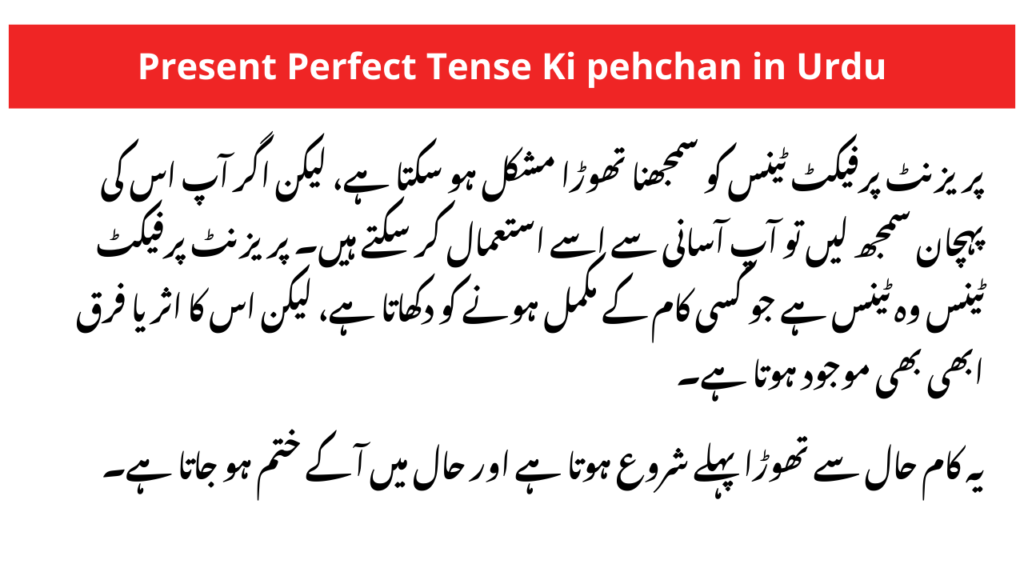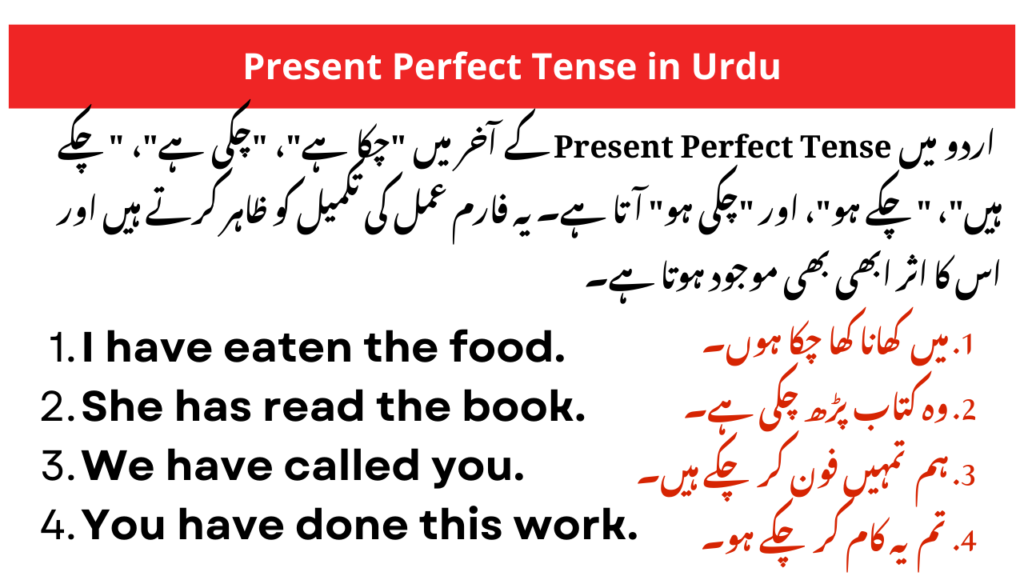In this post, you will find a Comprehensive Guide to Present Perfect Tense in Urdu with explanations and examples.
When learning English, one of the most important tenses to understand is the Present Perfect Tense. It’s commonly used in written and spoken English, yet its use can sometimes be confusing for learners, especially those whose native language is Urdu. In this blog post, we’ll explore how the Present Perfect Tense works in English, examples in Urdu will clarify the concepts more.

What is the Present Perfect Tense?
The Present Perfect Tense is a verb tense used to describe:
- Actions that have been completed at some point in the past (before the present time). but are still relevant to the present.
- Actions that began in the past and continue into the present.
In English, the Present Perfect Tense is formed using the auxiliary verb “have/has” followed by the past participle (3rd form) of the main verb.
Structure of the Affirmative Sentence in Present Perfect Tense:
Subject + has/have + Past Participle (3rd form of verb) + Object
Structure of the Negative Sentence in Present Perfect Tense:
Subject + has/have + not + Past Participle (3rd form of verb) + Object
Structure of the Interrogative Sentence in Present Perfect Tense:
Has/Have + Subject + Past Participle (3rd form of verb) + Object?
Structure of the Wh-family Interrogative Sentence in Present Perfect Tense:
Wh family word + Has/Have + Subject + Past Participle (3rd form of verb) + Object?
For example:
- I have finished my homework.
- She has visited Paris.
But what about its equivalent in Urdu?
Present Perfect Tense in Urdu
In Urdu, the Present Perfect Tense expresses actions that have been completed in the past but are related to the present. Its endings in Urdu and examples in Urdu and English are as follows:

Here are some examples to help you understand the structure:
-
میں نے کھانا کھا لیا ہے۔
(Main ne khana kha liya hai)
Translation: I have eaten the food. -
اس نے کتاب پڑھ لی ہے۔
(Us ne kitaab parh li hai)
Translation: She has read the book. -
ہم نے تمہیں فون کر لیا ہے۔
(Hum ne tumhein phone kar liya hai)
Translation: We have called you.
In these examples, the verb “ہے” (hai) changes according to the subject (main, us, hum), and the past participle “کھا لیا” (kha liya), “پڑھ لی” (parh li), and “فون کر لیا” (phone kar li) indicates the completion of the action.
How is it Different from Other Tenses?
The Present Perfect Tense in Urdu is often confused with the Simple Past Tense. While the Simple Past Tense refers to actions completed in the past with no connection to the present, the Present Perfect Tense indicates that the action has a present relevance or connection.
For example:
-
Simple Past Tense (Urdu):
میں نے کھانا کھایا۔
(Main ne khana khaya)
Translation: I ate the food. (No relevance to the present moment) -
Present Perfect Tense (Urdu):
میں نے کھانا کھا لیا ہے۔
(Main ne khana kha liya hai)
Translation: I have eaten the food. (The action is completed, but there is an implication that the effect of eating is present—maybe I’m no longer hungry, or the food is finished.)
Usage of Present Perfect Tense in Urdu:
-
Actions Completed Recently
When describing an action that was recently completed, the Present Perfect Tense is used in both English and Urdu. For instance:- میں نے ابھی اس سے بات کی ہے۔
(Main ne abhi us se baat ki hai)
Translation: I have just spoken to him/her.
The use of “ابھی” (abhi) here indicates the recent completion of the action.
- میں نے ابھی اس سے بات کی ہے۔
-
Experiences and Achievements
The Present Perfect Tense in Urdu is also used to express experiences, accomplishments, or changes that have happened over time:- وہ پچھلے سال لندن جا چکا ہے۔
(Woh pichlay saal London ja chuka hai)
Translation: He has been to London last year.
The sentence implies that he went to London at some point in the past, but this experience is relevant to the present conversation.
- وہ پچھلے سال لندن جا چکا ہے۔
-
States that Began in the Past and Continue to the Present
When describing situations that started in the past and continue in the present, we use the Present Perfect Tense in both languages:- میں یہاں پانچ سال سے رہ رہا ہوں۔
(Main yahan paanch saal se reh raha hoon)
Translation: I have lived here for five years.
This shows that the action of living started in the past and continues to the present.
- میں یہاں پانچ سال سے رہ رہا ہوں۔
Common Mistakes to Avoid:
-
Incorrect Use of “ہو” (ho)
A common mistake is using the verb “ہو” incorrectly. In the Present Perfect Tense, it is important to ensure that we use it with the past participle. Incorrectly saying “میں نے کھانا کھا ہو” is not correct. The right form is “میں نے کھانا کھا لیا ہے”. -
Overuse of Simple Past Tense
Learners sometimes overuse the Simple Past Tense when the Present Perfect Tense is more appropriate. For example, “میں نے کتاب پڑھی ہے” should be “میں نے کتاب پڑھ لی ہے” if the focus is on the completion of the action.
Conclusion:
Understanding the Present Perfect Tense in both English and Urdu can be tricky for many learners, but with practice, it becomes easier to master. The key difference lies in its ability to connect past actions to the present, whether it’s through personal experiences, recent actions, or ongoing situations. In Urdu, the structure is relatively straightforward once you understand the use of the past participle of the verb.
With consistent practice and awareness of when to use the Present Perfect Tense, you’ll be able to express actions that bridge the past and the present fluently in both English and Urdu.
Also Read some Useful Resources:
Present Indefinite Tense in Pehchan in Urdu
Present Continuous Tense in Urdu
Present Indefinite tense Examples in Urdu
To watch the Video Lectures, click on the link given below:

